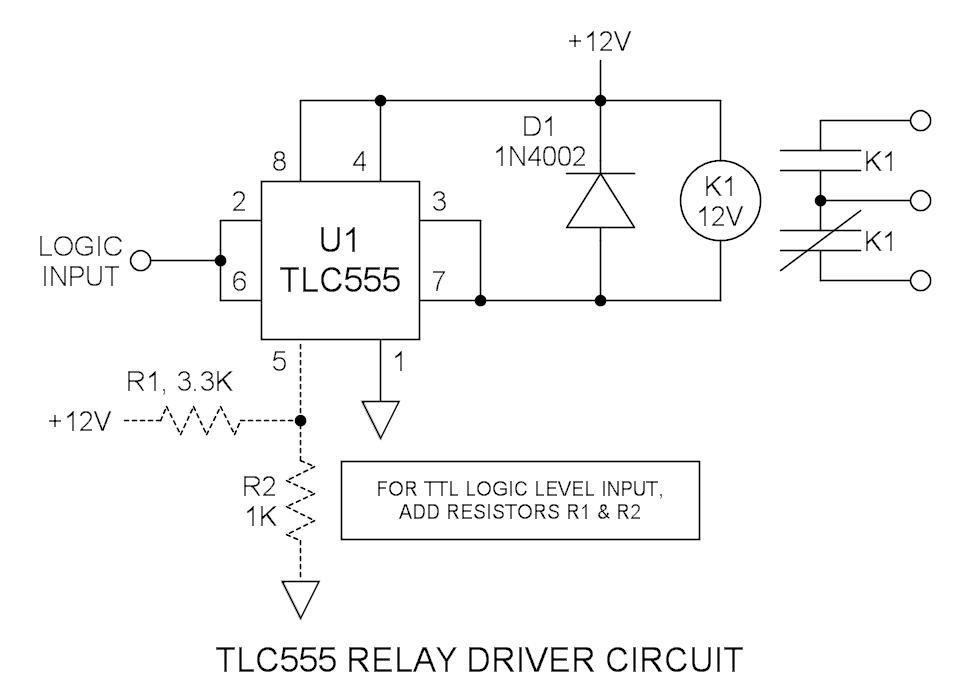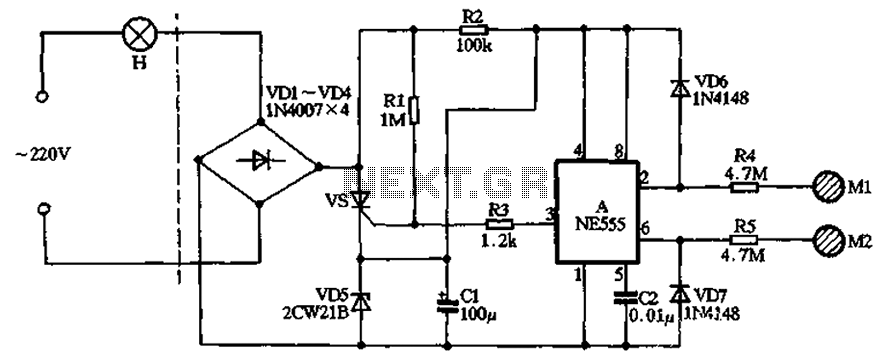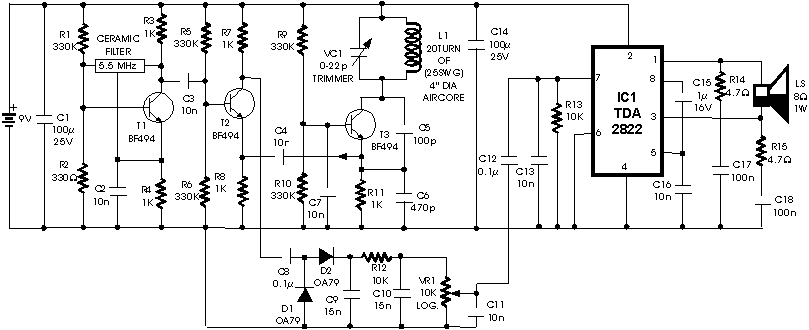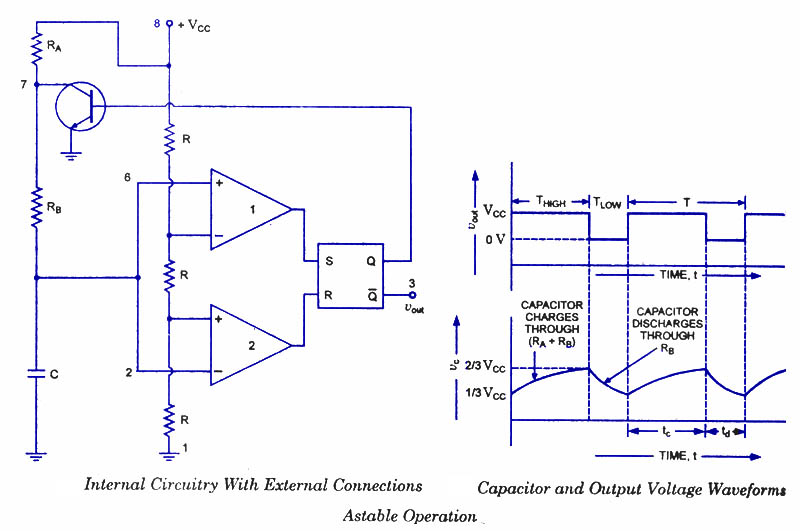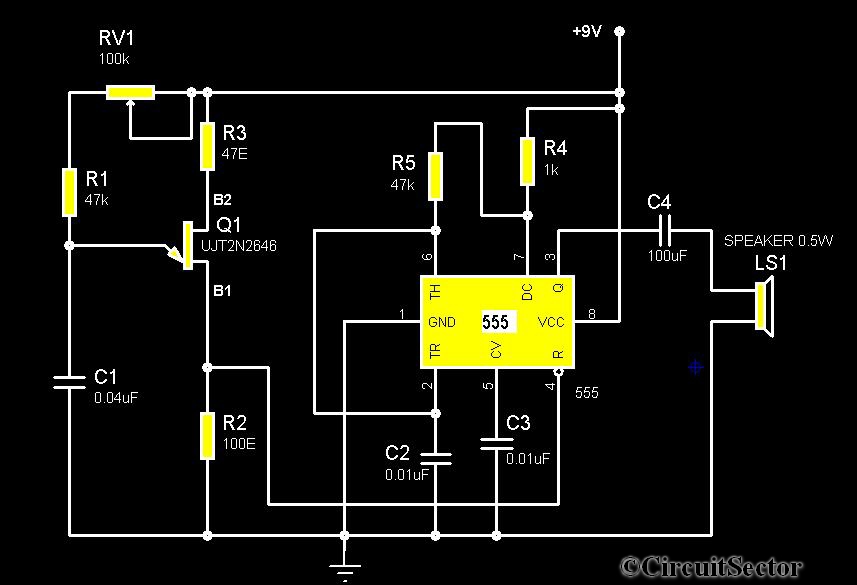
555 double coil metal detectors
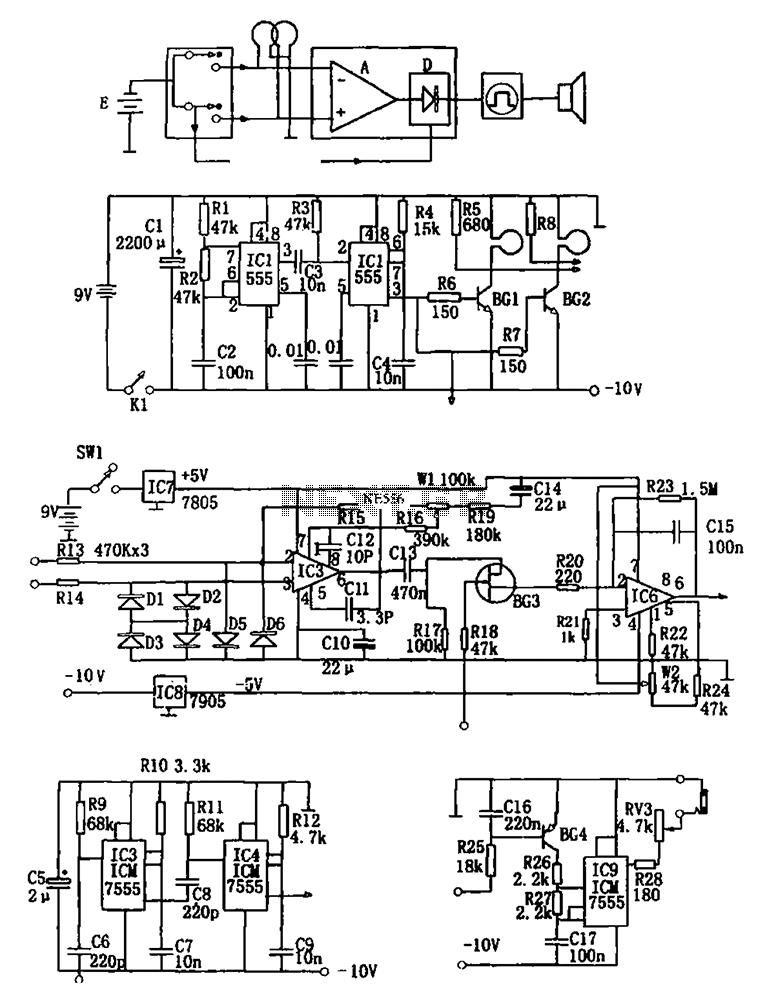
The figure illustrates a double coil metal detector circuit, which consists of a probe, a transmitter, a receiver, a timer, sound transmitters, and other components. The transmitter circuit, depicted in (b), is composed of a multivibrator (IC1, R1, R2, C2) and a single stabilizer (IC2, R4, C4). The timer IC2 is triggered by the output pulse from the multivibrator IC1. The oscillation frequency is calculated as f = 1.44 / ((R1 + 2R2) * C2), with a corresponding frequency parameter of approximately 100 Hz. The timer's duration is given by td = 1.1 * R4 * C4, with a corresponding parameter of about 165 microseconds. During the timing period, the output from the enable pin of IC2 activates BG1 and BG2, causing them to conduct. The receiving circuit, shown in (c), mainly consists of a differential amplifier and a detector amplifier. The differential amplifier IC5 (μA709CP) amplifies the sensor signal from the coil, and the amplified signal is processed through BG3 to the sense amplifier IC6. The timing circuit, illustrated in Figure (d), comprises two monostable delay circuits IC3 (R10, C7) and IC4 (R12, C9), which control the outputs. The delay time for the first circuit is td1 = 1.1 * R12 * C9, with a parameter of about 36 microseconds, while the second circuit has a delay time td2 = 1.1 * R10 * C7, corresponding to approximately 50 microseconds. The output signal is provided to the receiver BG3, which opens the gates. The sound generator, depicted in (e), is primarily composed of a 555 timer (IC9), BG4, R26, R27, C17, and other components forming a multivibrator. When the sensor signal indicates no metal presence, the output from IC6 keeps BG4 off, preventing the multivibrator from operating and resulting in no sound from the speaker. As a metal object approaches the search coil, the sensor signal increases, causing BG4 to conduct, which alters the operational state of the multivibrator. Consequently, the oscillation frequency of IC9 rises, leading to a high-frequency output that drives the speaker, signaling the presence of metal.
The double coil metal detector circuit operates based on the principle of electromagnetic induction, utilizing two coils to create a magnetic field. The transmitter coil generates an alternating magnetic field, which interacts with metallic objects within its vicinity. When a metal object enters the magnetic field, it induces eddy currents in the object, which in turn generate their own magnetic field. The receiver coil detects changes in the magnetic field caused by the presence of the metal object.
The multivibrator circuit (IC1) is configured to produce a square wave output, which is essential for driving the transmitter coil. The frequency of oscillation is dependent on the resistor and capacitor values in the circuit, allowing for adjustments to the sensitivity of the detector. The output pulse from the multivibrator triggers the timer (IC2), which controls the timing of the signal processing.
The differential amplifier (IC5) is crucial for amplifying the weak signals received from the coils. It enhances the detection capability of the circuit by increasing the signal-to-noise ratio, allowing for more reliable detection of metallic objects. The subsequent sense amplifier (IC6) further processes the amplified signal, preparing it for output to the timing circuit.
The timing circuit is responsible for generating precise delays, enabling the circuit to filter out false signals and respond only to significant changes in the detected signal. The two monostable circuits (IC3 and IC4) work in tandem to ensure that the output is stable and reliable.
The sound generator circuit adds a user-friendly interface to the metal detector. By producing an audible signal when metal is detected, it provides immediate feedback to the user, indicating the presence of metal without the need for visual indicators. The use of a 555 timer in the sound generator allows for easy adjustments to the tone and volume of the sound produced, enhancing the overall user experience.
In summary, this double coil metal detector circuit integrates various components to achieve efficient metal detection through electromagnetic principles, offering a practical solution for users in various applications, from treasure hunting to security. As shown in the following figure is double coil metal detector circuit. The probe by the probe, a transmitter, a receiver, a timer and sound transmitters and other components. Transmitter circuit shown in (b), by the multivibrator (IC1, R1, R2, C2), single stabilizer (IC2, R4, C4) composition, and the timer IC2 by multivibrator IC1 output pulse trigger. Oscillation frequency of f 1.44/(R1 + 2R2) C2, the corresponding icon parameter is about 100Hz. Timer in time td l.1R4C4, icon parameter corresponding to approximately 165 mu s. In the timing, (high) signal from the output enable pin IC2 BG1, BG2 saturated conduction. Receiving circuit shown in (c), mainly by the differential amplifier and the detector amplifier. Tibetan differential amplifier IC5 ( mu A709CP) the sensor signal diagram (b) of the coil differential amplification, the amplified signal during the open gates of a timing circuit through BG3, to the sense amplifier IC6.
A timing circuit shown in Figure (d) shown by the two monostable delay circuit IC3, R10, C7 and IC4, R12, C9 composition than, IC3 and IC4 by the output control. Wherein the delay time of the former is td l.1R12C9, icon parameter corresponding to about 36 mu s; the latter hope to delay time td2 1.1R10C7, icon parameter corresponding to about 50 mu s, the output signal supplied to receiver BG3, as open gates.
Sound generator as shown in (e), the core is composed of 555 (IC9), BG4, R26, R27, C17 and other multivibrator composed. When the metal-free sensor signal from the signal output enable pin IC6 BG4 off multivibrator does not work, corresponding speaker does not sound.
When metal sensing signal, and gradually close to the search coil metal body, the sensor signal becomes large, BG4 conduction situation changed for the better, so that the oscillation frequency IC9 gradually increased, when close to the metal body, high output by the IC9 oscillation frequency signal drives the speaker issued a high-frequency sound, it indicates there is a metal object.
The double coil metal detector circuit operates based on the principle of electromagnetic induction, utilizing two coils to create a magnetic field. The transmitter coil generates an alternating magnetic field, which interacts with metallic objects within its vicinity. When a metal object enters the magnetic field, it induces eddy currents in the object, which in turn generate their own magnetic field. The receiver coil detects changes in the magnetic field caused by the presence of the metal object.
The multivibrator circuit (IC1) is configured to produce a square wave output, which is essential for driving the transmitter coil. The frequency of oscillation is dependent on the resistor and capacitor values in the circuit, allowing for adjustments to the sensitivity of the detector. The output pulse from the multivibrator triggers the timer (IC2), which controls the timing of the signal processing.
The differential amplifier (IC5) is crucial for amplifying the weak signals received from the coils. It enhances the detection capability of the circuit by increasing the signal-to-noise ratio, allowing for more reliable detection of metallic objects. The subsequent sense amplifier (IC6) further processes the amplified signal, preparing it for output to the timing circuit.
The timing circuit is responsible for generating precise delays, enabling the circuit to filter out false signals and respond only to significant changes in the detected signal. The two monostable circuits (IC3 and IC4) work in tandem to ensure that the output is stable and reliable.
The sound generator circuit adds a user-friendly interface to the metal detector. By producing an audible signal when metal is detected, it provides immediate feedback to the user, indicating the presence of metal without the need for visual indicators. The use of a 555 timer in the sound generator allows for easy adjustments to the tone and volume of the sound produced, enhancing the overall user experience.
In summary, this double coil metal detector circuit integrates various components to achieve efficient metal detection through electromagnetic principles, offering a practical solution for users in various applications, from treasure hunting to security. As shown in the following figure is double coil metal detector circuit. The probe by the probe, a transmitter, a receiver, a timer and sound transmitters and other components. Transmitter circuit shown in (b), by the multivibrator (IC1, R1, R2, C2), single stabilizer (IC2, R4, C4) composition, and the timer IC2 by multivibrator IC1 output pulse trigger. Oscillation frequency of f 1.44/(R1 + 2R2) C2, the corresponding icon parameter is about 100Hz. Timer in time td l.1R4C4, icon parameter corresponding to approximately 165 mu s. In the timing, (high) signal from the output enable pin IC2 BG1, BG2 saturated conduction. Receiving circuit shown in (c), mainly by the differential amplifier and the detector amplifier. Tibetan differential amplifier IC5 ( mu A709CP) the sensor signal diagram (b) of the coil differential amplification, the amplified signal during the open gates of a timing circuit through BG3, to the sense amplifier IC6.
A timing circuit shown in Figure (d) shown by the two monostable delay circuit IC3, R10, C7 and IC4, R12, C9 composition than, IC3 and IC4 by the output control. Wherein the delay time of the former is td l.1R12C9, icon parameter corresponding to about 36 mu s; the latter hope to delay time td2 1.1R10C7, icon parameter corresponding to about 50 mu s, the output signal supplied to receiver BG3, as open gates.
Sound generator as shown in (e), the core is composed of 555 (IC9), BG4, R26, R27, C17 and other multivibrator composed. When the metal-free sensor signal from the signal output enable pin IC6 BG4 off multivibrator does not work, corresponding speaker does not sound.
When metal sensing signal, and gradually close to the search coil metal body, the sensor signal becomes large, BG4 conduction situation changed for the better, so that the oscillation frequency IC9 gradually increased, when close to the metal body, high output by the IC9 oscillation frequency signal drives the speaker issued a high-frequency sound, it indicates there is a metal object.
